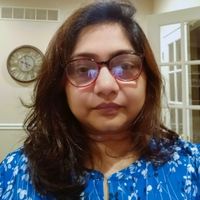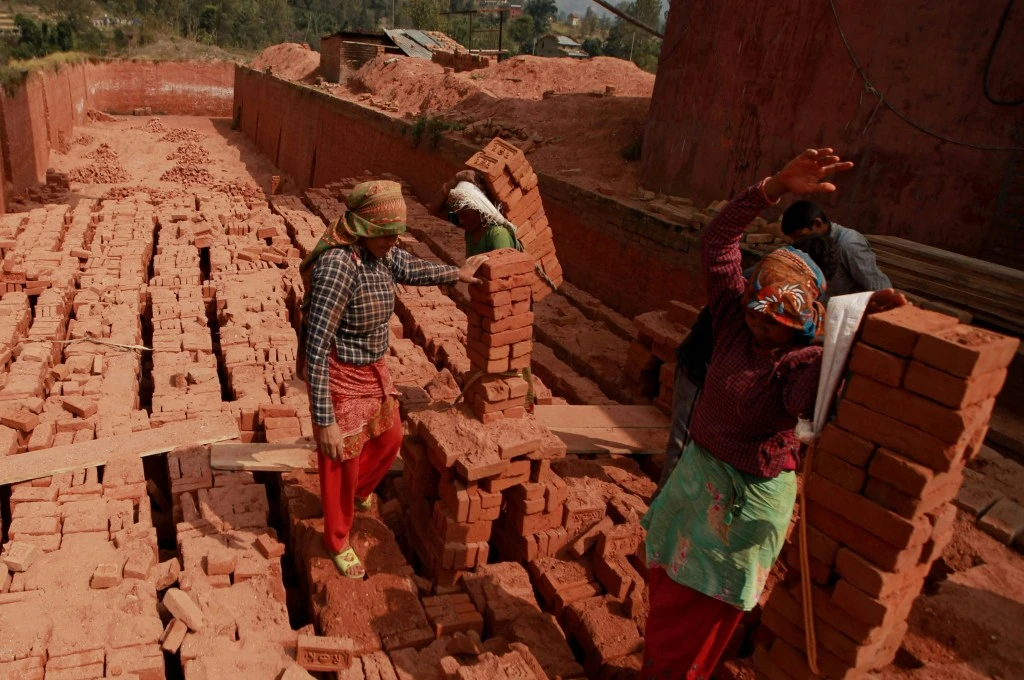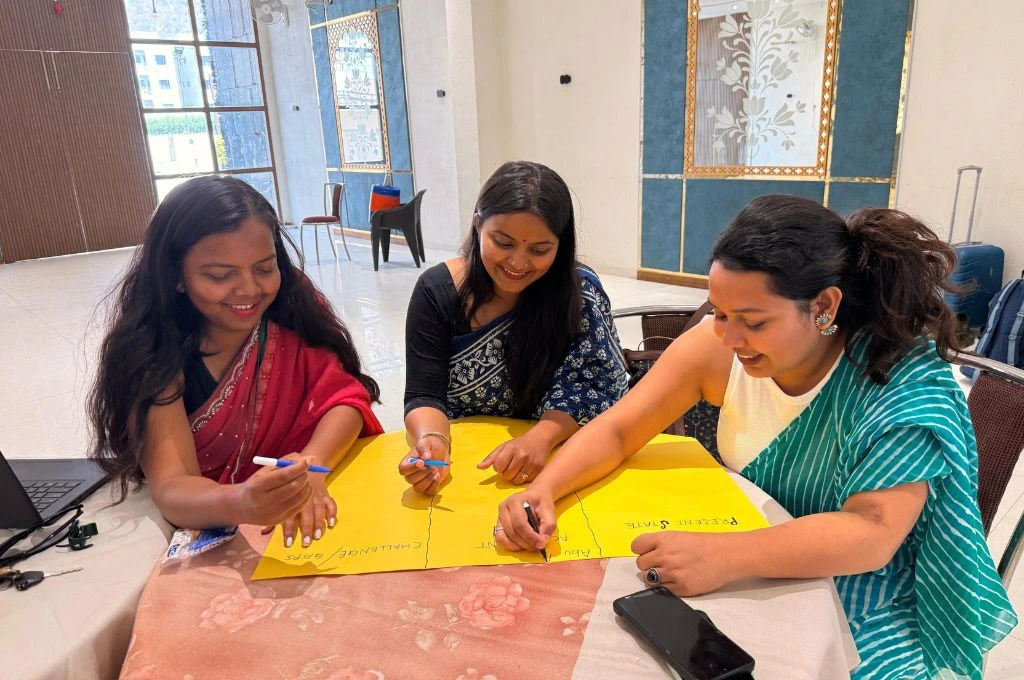লাতুর ভূমিকম্পের পরিপ্রেক্ষিতে একটি পাইলট প্রকল্পে, এক হাজারেরও বেশি মহিলা পুনর্বাসন কাজের জন্য সরকার এবং তাদের সম্প্রদায়ের মধ্যে সহায়তাকারী হিসাবে নেতৃত্ব দিয়েছিলেন। প্রায় 30 বছর পরে, মহিলাদের সংগঠিত হয়ে কাজ করার এই মডেলটি ভূমিকম্প, সুনামি, ঘূর্ণিঝড়, খরা এবং অতি সম্প্রতি মহামারীর সময় প্রমান করেছে যে এটি একটি কার্যকরী মডেল।
স্বয়ম শিক্ষান প্রয়োগ (এসএসপি), যে সংস্থাটি মারাঠওয়াড়ার লাতুরে পাইলট থেকে বেড়ে উঠেছিল, সেটি আনুষ্ঠানিকভাবে ১৯৯৮ সালে রেজিস্টার্ড হয়। প্রতিষ্ঠাতা এবং সামাজিক কর্মী, প্রয়াত প্রেমা গোপালন বিশ্বাস করতেন যে মানুষ যখন বিপদের সম্মুখীন হোন, সেই পরিস্থিতি মহিলাদের জন্য তাদের সম্প্রদায়ে নেতৃত্বের ভূমিকা নেওয়ার একটি সুযোগ হিসেবে দেখা যেতে পারে । আজ, এসএসপির ৫,000 মহিলা পরিবর্তন প্রতিনিধি হিসেবে সম্প্রদায়ের সাথে কাজ করেন। সখী (বা বন্ধু) নামে পরিচিত এই পরিবর্তন প্রতিনিধিরা প্রায় 3,00,000 নারীকে উদ্যোক্তা, কৃষক এবং সম্প্রদায়ের নেতা হিসেবে ক্ষমতায়ন করেছেন ।
জলবায়ু সংকটের বিরুদ্ধে লড়াইয়ে, এসএসপির সখীরা গ্রামীণ ভারতে সামনের সারিতে থেকে কাজ করে চলেছেন। মহারাষ্ট্রে র মারাঠওয়াড়া কৃষকের আত্মহত্যার জন্য কুখ্যাত। যেখানে খরা প্রবন অঞ্চল হওয়া সত্ত্বেও দীর্ঘদিন ধরে অর্থকরী ফসলের চাষ করা হয় যাতে পুজিঁ ব্যায় হয়, যা একটি কৃষি সঙ্কট তৈ রী করেছে। বছরের ক্রমাগত অনিয়মিত বৃষ্টিপাত এবং বাজার বাহিনীর কারণে অনেক কৃষক পরিবার বারবার ক্ষতির সম্মুখীন হয়েছে। এই সব কারণে ঋণ, দুর্দশা অভিবাসন এবং ক্ষুদাজনিত সমস্যা বেড়ে চলেছে । এই ধরণের পরিস্থিতিতে এসএসপির সখীরা ছোট ও প্রান্তিক মহিলা কৃষকদের মধ্যে চাষের এক একর মডেলকে প্রচার করেছেন। এই মডেল অনুযায়ী কৃষির জন্য একটি জলবায়ু-স্থিতিস্থাপক পদ্ধতিতে এক একর জমিতে খাদ্য শস্যের বিভিন্ন মিশ্রণ জন্মাতে বায়ো ইনপুট ব্যবহার করা হয় ।
এই অঞ্চলের ক্ষুদ্র ও প্রান্তিক মহিলা কৃষকরা যারা এক একর মডেলে চাষ করেছেন তাদের ফসলের ফলন 25 শতাংশ পর্যন্ত বৃদ্ধি পেয়েছে। উল্লেখযোগ্যভাবে, খরার বছরগুলিতে, এবং মহামারীর সময়ে, এই কৃষকরা তাদের ছোট অথচ উৎপাদনশীল জমি থেকে তাদের পরিবারকে খাওয়াতে সক্ষম হয়েছে।
এসএসপির মডেলটির কার্যকারিতার মুলে কি রয়েছে?
মহিলাদের দ্বারা, মহিলাদের জন্য
এসএসপি-এর সখীরা তাদের সম্প্রদায়ের বিভিন্ন প্রয়োজনে কাজ করেন।তাদের কাজ তাদের নিজস্ব কাজ করার পরিসরকেও বাড়াতে সাহায্য করে। এর মূল উদ্দেশ্য হল প্রান্তিক গ্রামীণ মহিলাদের মূল স্রোতে নিয়ে আসা এবং তার সাথে বিভিন্ন নেতৃত্বের ভূমিকায়ও তাদের নিয়ে আসা যাতে তারা জনসাধারণের জন্য কাজ করতে পারেন।
এসএসপি-র সহযোগী পরিচালক নাসিম শাইক, যিনি লাতুরে পাইলট হওয়ার পর থেকে সংস্থার সাথে রয়েছেন, বলেছেন, “আমি মারাঠাওয়াড়া, তামিলনাড়ু, ওড়িশা, শ্রীলঙ্কা এবং তুরস্কে দুর্যোগ পুনর্বাসনে মহিলাদের কাজ করতে দেখেছি৷ এই সমস্ত জায়গায় তারা কেউ তাদের হাতে দায়িত্ব তুলে দেবার অপেক্ষায় থাকেনি। মহিলারা তাদের সন্তান, বৃদ্ধ, পরিবার, সম্প্রদায়, এমনকি প্রাণীদের জন্য সমাজসেবক কাজ হাতে তুলে নেন।”
কৃষিক্ষেত্রে, পুরুষরা যখন অন্য শহর বা দেশে চলে যান বা অ-কৃষি চাকরিতে স্থানান্তরিত হন তখন মহিলারা চাষের দায়িত্ব নেন। যদিও তাদের ভূমিকাকে শুধুমাত্র শ্রম হিসেবে দেখা হয়।তাদেরকে মালিক বা কৃষক হিসাবে দেখা হয় না এবং কোন ফসলের চাষ হবে, কতটা চাষ হবে, কতটা বিক্রি হবে এবং গৃহস্থালিতে ব্যবহার কতটা হবে সে বিষয়ে সিদ্ধান্ত নেয়ার অধিকার তাদের থাকে না ।
এসএসপি এটি পরিবর্তন করার সিদ্ধান্ত নিয়েছে । গত এক দশকে, তারা 75,000 এর বেশি মহিলা কৃষককে তাদের পরিবারের সাথে এক একর পারিবারিক জমির শিরোনামের জন্য আলোচনা করতে সহায়তা করেছে, যা তারা বাজরা, ডাল এবং শাক-সবজি সহ পুষ্টি সমৃদ্ধ ফসল ফলাতে ব্যবহার করেছে। যাদের এই বিকল্প নেই, তারা বড় কৃষকদের কাছ থেকে জমি লিজ নিয়েছেন। যে দেশে নারীরা উত্তরাধিকারে 2 শতাংশেরও কম কৃষি জমির মালিকানা পান, এবং উত্তরাধিকার আইনে কোনো পরিবর্তনের পরিকল্পনা আপাদত নেই, সেখানে এটি একটি ভালো বিকল্প। মহিলারা অনেক সময় দেখিয়ে দিয়েছেন যে যখন বড় কৃষকদের সমস্যা হয়, এই প্জমি গুলি তাদের পরিবারকে খাওয়ার যোগান দিতে পারে। এটি তাদের প্রভাবশালী করে তোলে।
গ্রামীণ এলাকায় যেখানে এসএসপি কাজ করে, সামাজিক নিয়মের কারণে মেয়েদের স্কুল ছেড়ে দিতে হয় বা তাদের তাড়াতাড়ি বিয়ে হয়ে যায়। নাসিম বিশ্বাস করেন যে তাদের মধ্যে অনেকেই নিজেদের ব্যক্তিত্ব প্রকাশ করার জন্য এসএসপি মাধ্যমে দেওয়া সুযোগগুলি পেতে চায়। এসএসপির পর জন্ম হয় যখন নারী সংবাদ সহায়করা, যারা লাতুরে পুনর্বাসনের কাজ করেছিলেন, তারা প্প্রেমাকে বলেছিলেন যে শুধুমাত্র বাড়িতে বসে থাকার জন্য তারা ফিরবেন না.
হিন্দুস্তান ইউনিলিভার ফাউন্ডেশনের পোর্টফোলিও এবং অংশীদারিত্বের প্রধান অনন্তিকা সিং বলেছেন, “আমরা অনেক সংস্থার সাথে কাজ করি। কিন্তু সখীরা তৃনমুল স্তরে যে প্রভাব ফেলেছেন, তা সত্যিই দেখার মতো। কিছু সংস্থায়, মহিলারা সুবিধাভোগী কিন্তু অংশগ্রহণকারী নয়। কিছু অন্নান্য সংস্থায় মহিলারা ক্রমস্য উপরে উঠে অংশগ্রহণ করতে পারে । এসএসপিতে মহিলারা নেতৃত্বের ভূমিকায় রয়েছেন। তারা উপস্থিতি এবং শুধুমাত্র অংশগ্রহণকারীত্ব থেকে নেতৃত্বের ভূমিকায় মহিলাদের সরিয়ে আনতে পেরেছেন।”

বেরিয়ে এসে, উপরের দিকে ওঠা
প্রেমা বিশ্বাস করতেন যে নারীদের প্রশিক্ষণের চেয়ে সুযোগের বেশি প্রয়োজন। নাসিম বলেন, “আমরা সখীদের শিক্ষিত করার জন্য টেকনোক্র্যাটিক টপ-ডাউন পদ্ধতি বা তথাকথিত শ্রেণীকক্ষ ব্যবহার করি না । আমরা অনানুষ্ঠানিক পিয়ার লার্নিং এর উপর বেশি নির্ভর করি,”।
এটি কোনও সহজ কাজ নয়, কারণ সখীদের ভূমিকা পালন করার জন্য মহিলাদের সরকারী কর্মকর্তা, গ্রাম পঞ্চায়েত এবং বড় কৃষকদের সাথে লবিং করতে হয়। এই জনসাধারণের ভূমিকার জন্য প্রয়োজনীয় আস্থা এবং দক্ষতা অর্জন করতে তাদের প্রায়শই দুই বছর সময় লেগে যায়।
বহু বছরের চেষ্টায় এসএসপি সখীদের জন্য একটি প্রশিক্ষণ মডিউল তৈরি করেছে। যদিও নাসিমের মতে, সবচেয়ে গুরুত্বপূর্ণ বিষয় হল মহিলারা বাড়ির বাইরে বেরিয়ে বিভিন্ন সুযোগের অবকাশ পান। “প্রথমত, আমরা সখীদের নিজেদের জীবন সুরক্ষিত করতে সাহায্য করি। তারপর তাদের সম্প্রদায়ের জন্য কাজ করার জন্য বিভিন্ন ভূমিকা দেওয়া হয়। ধীরে ধীরে, তারা অন্যান্য গ্রামে যায় এবং নতুন দলের সাথে কথা বলে। এতে তাদের আত্মবিশ্বাস বেড়ে যায়। সময়ের সাথে সাথে, তারা ব্লক স্তরে সরকারি কর্মকর্তাদের সাথেও দেখা করে।” এসএসপি-র একজন প্রশিক্ষক কাকা আডসুলে বলেছেন যে নারীদের প্রয়োজনীয় সফট স্কিল অর্জনের জন্য রোল মডেল গুরুত্বপূর্ণ।
যেহেতু সংগঠনটি প্রথমে প্রতিটি সখীকে তার নিজস্ব আর্থিক এবং সামাজিক সমস্যা মোকাবেলায় সাহায্য করে, এটি এমন একটি পরিবেশ তৈরি করে যেখানে নারীরা অন্যদের জন্যও কাজ করতে অনুপ্রাণিত হয়।
শেখার জন্য গবেষণা
সংগঠনের নাম-স্বয়ম শিক্ষা প্রয়োগ-এর আক্ষরিক অর্থ হল স্ব-শিক্ষা এবং গবেষণা, এবং এটি সংগঠনের সমস্ত কিছুর ডিএনএ-তে অন্তর্ভুক্ত। এসএসপি সখীদের তাদের নিজস্ব খামার এবং ব্যবসাগুলিকে ল্যাব হিসাবে ব্যবহার করতে উত্সাহিত করা হয় যেখানে তারা নতুন পদ্ধতির পরখ করে নিয়ে অন্যদের সাথে সেই শিক্ষা ভাগ করে নেয়।
একদিকে, সরকারের কৃষি বিজ্ঞান কেন্দ্র নলেজ নেটওয়ার্কের বিশেষজ্ঞরা সখীদের তাদের ল্যাব-টু-ল্যান্ড ট্রায়ালে সহায়তা করে । অন্যদিকে, মহিলারা তাদের নিজস্ব দক্ষতা এবং ঐতিহ্যগত জ্ঞান নিয়ে আসে। উদাহরণস্বরূপ, যখন সখীদের ড্রিপ সেচ সম্পর্কে শেখানো হয়েছিল কিন্তু বাজার থেকে এই সিস্টেমগুলি সংগ্রহ করার জন্য সংস্থান ছিল না, তখন তারা ছিদ্রযুক্ত পাইপগুলিকে স্প্রিংকলার হিসাবে ব্যবহার করতে শুরু করেছিল। এটি সস্তাও ছিল এবং নমনীয়ও ছিল। মহিলা কৃষকরাও শস্য সংরক্ষণের সময় পোকামাকড়ের উপদ্রব রোধ করতে সার হিসাবে অ্যাজোলা (একটি জলজ ফার্ন) এবং নিম পাতা ব্যবহার করার মতো ঐতিহ্যগত পদ্ধতিগুলি ফিরিয়ে এনেছে।
বৈশালী বালাসাহেব ঘুগে , একজন প্রশিক্ষক, বলেছেন যে অন্য কৃষকদের কাছে সুপারিশ করার আগে তিনি নিজেই সবকিছু পরখ করে দেখেন। তার মনে আছে যে যখন তিনি তার এক একর খামার শুরু করেছিলেন তখন তার বর্ধিত পরিবারের সদস্যরা তার অস্বাভাবিক অনুশীলনে আমোদিত হয়েছিল, এবং তারা এখন তার পরামর্শ নেয়। তিনি যখন ভার্মিকম্পোস্টিং অনুশীলন শুরু করেছিলেন, তখন তার সবচেয়ে বড় সাথী ছিল সেই আম গাছটি যার নীচে তিনি এটি স্থাপন করেছিলেন। গাছটি এত ভালো ভাবে বৃদ্ধি পেয়েছিলো যে অন্যান্য কৃষকরা সহজেই তাদের ফসল এবং খেত গুলিকে পুষ্ট করার জন্য এই পদ্ধতিটি ব্যবহার করার বিষয়ে রাজি হয়ে গিয়েছিলো।
নাসিম উল্লেখ করেছেন যে যখনই এসএসপি একটি নতুন প্রকল্প শুরু করে, দলটি শুধুমাত্র সম্প্রদায়ের সাথে ভাগ করে নেওয়ার মতো জ্ঞানই নয়, এমনকি তারা এই প্রকল্প থেকে কী শিখতে পারে তার উপরও একটি রোড ম্যাপ তৈরি করে। তিনি বলেন, “বিশেষজ্ঞ এবং বহিরাগতরা একটি সম্প্রদায়ের পারস্পরিক বোঝাপড়া বুঝতে পারে না।” বোর্ডে একটি সখী আনার পাশাপাশি , এসএসপি একটি গ্রাম অ্যাকশন গ্রূপ তৈরি করেছে যেখানে গ্রাম পঞ্চায়েতের প্রতিনিধি এবং প্রান্তিক গোষ্ঠীর লোক সহ বিভিন্ন স্টেকহোল্ডারদের অন্তর্ভুক্ত করা হয়।
বেঁচে থাকা, ভালো থাকা এবং নেতৃত্ব
যখন এসএসপি মহিলা কৃষকদের এক একর প্লট স্থাপনে সহায়তা করা শুরু করে, তখন তাদের প্রাথমিক উদ্দেশ্য ছিল এই পরিবারের জন্য খাদ্য নিরাপত্তা নিশ্চিত করা। এই মডেলটি এখন তার প্রচেষ্টা প্রসারিত করেছে এবং এই কৃষকদের খাদ্য মূল্য শৃঙ্খলে এগিয়ে যেতে সাহায্য করছে। এর মধ্যে কিছু মহিলা স্থানীয় পণ্য যেমন ডাল এবং খাদ্যশস্যের জন্য প্রক্রিয়াজাতকরণ উদ্যোগ স্থাপন করেছেন। অন্যরা কৃষি উপকরণ যেমন ভার্মিকম্পোস্ট উৎপাদন করে বা বিপন্ন জাতের বীজের অভিজ্ঞ বা বীজ মাতা হয়ে উঠেছে। তারা ক্রয়, প্রক্রিয়াকরণ এবং বিপণনের জন্য লিভারেজ লাভের জন্য গ্রুপ গঠন করেছে। কেউ কেউ পশুপালন, হাঁস-মুরগি এবং দুগ্ধজাতের মতো সহযোগী ব্যবসাও স্থাপন করেছে।
ব্লক কো-অর্ডিনেটর অর্চনা মানে বলেছেন যে তার একটি ব্যবসা অন্য বাবস্যার সুযোগ ও করে দেয় এবং সে এখন বছরে 10 লাখ টাকা আয় করে। এসএসপি-এর প্রশিক্ষণ এবং মেন্টরশিপ ইকোসিস্টেম মহিলাদের ব্যবসায়িক দক্ষতা, বিপণন সহায়তা, আর্থিক সাক্ষরতা, স্টার্ট-আপ মূলধন, এবং একটি লাস্ট-মাইল ডিস্ট্রিবিউশন নেটওয়ার্কের মাধ্যমে বড় কোম্পানিগুলির সাথে লিঙ্কও দেওয়া হয়। অর্চনা বলে, “এটা আমার জীবন পরিবর্তন করে দিয়েছে। আমি সবচেয়ে ভালো বেতনের চাকরির জন্যও উদ্যোক্তা হওয়ার এই সুযোগ ফিরিয়ে দেব না,”৷
দুর্যোগ ব্যবস্থাপনা হিসাবে যা শুরু হয়েছিল তা দীর্ঘ পথের জন্য একটি অভিযোজিত মডেল হিসাবে প্রমাণিত হয়েছে। নাসিম বলেছেন, “এসএসপি না থাকলেও সখীরা তার সম্প্রদায়ের জন্য একটি গুরুত্বপূর্ণ সম্পদ হয়ে থাকবে।”
যেহেতু প্রেমা ‘ভালো করে গড়ে তোলার’ অভিপ্রায়ে সখী আন্দোলনের সূত্রপাত করেছিলেন, সেহেতু সম্প্রদায়ের সম্পদ ব্যক্তি হিসাবে নারীদের ধারণা দেশে সাড়া ফেলেছে। এসএসপি একটি অনুলিপিযোগ্য পদ্ধতি তৈরি করেছে যা, একটি সম্প্রদায়ের চ্যালেঞ্জের প্রতি সাড়া দেওয়ার সময়, পরিকল্পনা এবং সিদ্ধান্ত গ্রহণের ক্ষমতা মহিলাদের হাতে রাখে এবং তাদের মধ্যে জননেতৃত্বের ভূমিকা গ্রহণের জন্য প্রয়োজনীয় আস্থা তৈরি করে । প্রতিটি সখীর কাজে যোগ দেয় মাধ্যমে , এবং তাদের সম্প্রদায়কে পরিবেশনের মাধ্যমে, প্রেমার উদ্যোগ বেঁচে থাকে ।
দেবজিৎ দত্ত এই নিবন্ধটিতে অবদান রেখেছেন।
—
আরও জানুন
- রেইনড্রপ ইন দ্য ড্রাট: গোদাবরী ডাঙ্গে থেকে এক একর চাষের মডেল সম্পর্কে আরও জানুন ।
- সামাজিক পরিবর্তনের জন্য কর্মসূচিতে তৃণমূলস্তরীয় জ্ঞানকে অন্তর্ভুক্ত করা কেন গুরুত্বপূর্ণ তা বুঝুন ।






